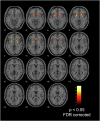PET/fMRI demonstrates that bariatric surgery may reverse striatal dopaminergic dysfunction in women with obesity
- PMID: 40877587
- PMCID: PMC12394448
- DOI: 10.1038/s43856-025-01079-z
PET/fMRI demonstrates that bariatric surgery may reverse striatal dopaminergic dysfunction in women with obesity
Abstract
Background: Central mechanisms may play a role in the success of bariatric surgery (BS), the treatment of choice for refractory obesity. We hypothesize that central dopaminergic receptor function in striatal brain regions is a pivotal mechanism in the success of BS.
Methods: We conducted a cross-sectional study to investigate central dopamine type 2 and 3 receptors (D2/3 R) within striatal brain regions in successful weight loss (WL) through BS. Positron Emission Tomography was used to map nondisplaceable binding potential (BPND) of D2/3 R in 48 women: 19 successful responders to BS, 12 with obesity (OB), and 17 normal-weight controls. Parametric maps were compared between-groups in regions of interest and at voxel-level. We also investigated brain blood oxygenation level-dependent (BOLD) responses to food content using functional Magnetic Resonance Imaging (fMRI) and how key variables correlate with D2/3 R binding.
Results: We find mean D2/3 R BPND significant differences between OB and controls in the ventral striatum (p = 0.042) and at voxel-level across striatum between OB and the other groups (p < 0.05). Food content (Food > Non-food, p = 0.05) reveals significantly higher neural activation in striatum also for OB compared to the other groups. Moreover, D2/3 R BPND values correlate with dysfunctional self-report measures of eating behaviors, incentive salience to food cue and high-calorie food preferences in obesity. Notably, BOLD responses (Food > Baseline) in striatum correlate positively with D2/3 R binding in ventral striatum.
Conclusions: Striatal dopaminergic dysfunction in obesity may enhance salience to food cues, driving cravings and compulsive eating. BS may reverse the striatal molecular and functional disruptions found in obesity.
Plain language summary
Bariatric surgery is a type of surgery that helps people with severe obesity lose weight. The success of this surgery may involve changes in the brain. This study investigated how these changes impact weight loss and eating behavior, focusing on dopamine, a brain chemical known to have an effect on pleasure, food cravings and eating behaviors. We used brain imaging to examine dopamine in women with successful weight loss after bariatric surgery, women with obesity, and normal weight women. We found that obesity is associated with changes in dopamine, which may contribute to food cravings and compulsive eating. Successful weight loss after bariatric surgery appear to reverse these changes. This work may help clarify how bariatric surgery promotes weight loss.
© 2025. The Author(s).
Conflict of interest statement
Competing interests: The authors declare no competing interests.
Figures







Similar articles
-
Prescription of Controlled Substances: Benefits and Risks.2025 Jul 6. In: StatPearls [Internet]. Treasure Island (FL): StatPearls Publishing; 2025 Jan–. 2025 Jul 6. In: StatPearls [Internet]. Treasure Island (FL): StatPearls Publishing; 2025 Jan–. PMID: 30726003 Free Books & Documents.
-
Ovarian hormones and obesity.Hum Reprod Update. 2017 May 1;23(3):300-321. doi: 10.1093/humupd/dmw045. Hum Reprod Update. 2017. PMID: 28333235 Free PMC article. Review.
-
Prevalence and associated factors of eating disorders among metabolic bariatric surgery patients in Egypt.J Eat Disord. 2025 Aug 25;13(1):182. doi: 10.1186/s40337-025-01373-0. J Eat Disord. 2025. PMID: 40855442 Free PMC article.
-
An Examination of Perceived Stress and Emotion Regulation Challenges as Mediators of Associations Between Camouflaging and Internalizing Symptomatology.Autism Adulthood. 2024 Sep 16;6(3):345-361. doi: 10.1089/aut.2022.0121. eCollection 2024 Sep. Autism Adulthood. 2024. PMID: 39371362
-
Nicotine receptor partial agonists for smoking cessation.Cochrane Database Syst Rev. 2016 May 9;2016(5):CD006103. doi: 10.1002/14651858.CD006103.pub7. Cochrane Database Syst Rev. 2016. Update in: Cochrane Database Syst Rev. 2023 May 5;5:CD006103. doi: 10.1002/14651858.CD006103.pub8. PMID: 27158893 Free PMC article. Updated.
References
LinkOut - more resources
Full Text Sources
Miscellaneous

